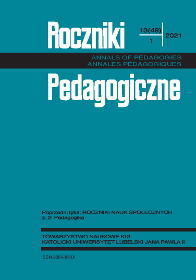The Potential of Psychosocietal Resilience from the Perspective of Human Resources. Pedagogical Implications
Main Article Content
Abstract
The life in times of pandemic caused by SARS-CoV-2 virus has become more difficult. Daily functioning requires introduction of changes, respecting new rules, facing higher requirements. The equilibrium between needs, actions and conditions has been shattered. Interesting thing is that some part of people despite difficulties remains engaged in their family and society life roles and at the same time acquires new roles such as supporting others. Facing huge burden, they remain creative, engaged and full of hope. Until now, the scientific research was focused mainly on stress resistance with emphasis of meaning of stress perception and individual differences. The pandemic situation presents the need to pay higher attention to positive engagement: creative functioning in the stressful environment. In the scientific research it is confirmed that acquiring various research for constructing potential of psychophysical resilience is meaningful.
The goal of this article is presentation of the meaning of shaping potential human psychophysical resilience as a task in upbringing. Psychophysical resilience is understood as the ability to leave negative consequences of difficult actions and the level of remaining engaged in important life duties, despite those incidents.
Shaping of the resilience potential in the upbringing has been presented in the resource context. The analysis of phenomenon and the meaning of resources was made. It was categorized according to the following criteria: relation in which the resources are against the subject, meaning belonging to one; the content of resources’ categories; the meaning of the resources for human survival. Seven mechanisms of resources actions were appointed, their connection with psychophysical resilience was explained. The concept of Stevan Hobfoll patterns was characterized.
Article Details
References
Antonovsky, A. (1995). Rozwikłanie tajemnicy zdrowia: Jak radzić sobie ze stresem i nie zachorować? Warszawa: Fundacja Instytutu Psychiatrii i Neurologii.
Bernat, A., Krzyszkowska M. (2017). Znaczenie i sposoby wykorzystania psychospołecznych zasobów zaradczych w ujęciu S.E. Hobfolla. Studia Paradyskie, 27, 255-278.
Bielawska-Batorowicz, E., Dudek, B. (red.). (2012). Teoria zachowania zasobów Stevana E. Hobfolla. Polskie doświadczenia. Łódź: Wydawnictwo Uniwersytetu Łódzkiego.
Finkelstein, D.M., Kubzansky, L.D., Capitman, J., Goodman, E. (2007). Socioeconomic differences in adolescent stress: The role of psychological resources. Journal of Adolescent Health, 40 (2), 127-234.
Gallo, L.C., Bogart, L.M., Vranceanu, A.-M., Matthews, K.A. (2005). Socioeconomic status, resources, psychological experiences, and emotional responses: A test of the reserve capacity model. Journal of Personality and Social Psychology, 88 (2), 386-399.
Heszen, I. (2012). Paradygmat stresu i radzenia sobie Lazarusa i Hobfolla – podejścia badawcze przeciwstawne czy komplementarne? W: E. Bielawska-Batorowicz, B. Dudek (red.), Teoria zachowania zasobów Stevana E. Hobfolla. Polskie doświadczenia (s. 51-64). Łódź: Wydawnictwo Uniwersytetu Łódzkiego.
Hobfoll, S.E. (1989). Conservation of Resources. A New Attempt at Conceptualizing Stress. American Psychologist, 44 (3), 513-24.
Hobfoll, S.E. (2002). Social and psychological resources and adaptation. Review of General Psychology, 6, 307-324.
Hobfoll, S.E. (2006). Stres, kultura i społeczność. Psychologia i filozofia stresu. Gdańsk: Wydawnictwo Psychologiczne.
Hobfoll, S.E. (2012). Teoria zachowania zasobów i jej implikacje dla problematyki stresu, zdrowia i odporności. W: E. Bielawska-Batorowicz, B. Dudek (red.), Teoria zachowania zasobów Stevana E. Hobfolla. Polskie doświadczenia (s. 17-49). Łódź: Wydawnictwo Uniwersytetu Łódzkiego.
Kaczmarska, A., Curyło-Sikora, P. (2016). Problematyka stresu – przegląd koncepcji. Hygeia Public Health, 51(4), 317-321.
Ratajczak, Z. (2000). Stres – radzenie sobie – koszty psychologiczne, W: I. Heszen-Niejodek, Z. Ratajczak (red.), Człowiek w sytuacji stresu. Problemy teoretyczne i metodologiczne (s. 65-87). Katowice: Wydawnictwo NAS.
Repetti, R.L., Taylor, S.E., Seeman, T.E. (2002). Risky families: Family social environments and the mental and physical health of offspring. Psychological Bulletin, 128(2), 330-366.
Schumm, J.A., Briggs-Phillips, M., Hobfoll, S.E. (2006). Cumulative interpersonal traumas and social support as risk and resiliency factors in predicting PTSD and depression among innercity women. Journal of Traumatic Stress, 19(6), 825-836.
Seligman, M.E.P., Csikszentmihalyi, M. (2000). Positive psychology. American Psychologist, 55, 5-14.
Sęk, H. (2001). Wprowadzenie do psychologii klinicznej. Warszawa: Wydawnictwo Naukowe Scholar.
Sęk, H. (2003). Wsparcie społeczne jako kategoria zasobów. W: Z. Juczyński, N. Ogińska-Bulik (red.), Zasoby osobiste i społeczne sprzyjające zdrowiu jednostki (s. 17-32). Łódź: Wydawnictwo Uniwersytetu Łódzkiego.
Sęk, H. (2012). Zastosowanie teorii zachowania zasobów S. Hobfolla do interpretacji mechanizmów działania zasobów w świetle wybranych badań z zakresu psychologii zdrowia. W: E. Bielawska-Batorowicz, B. Dudek (red.), Teoria zachowania zasobów Stevana E. Hobfolla. Polskie doświadczenia (s. 65-80). Łódź: Wydawnictwo Uniwersytetu Łódzkiego.
Sęk, H., Ścigła, I. (2000). Stres i radzenie sobie w modelu salutogenetycznym. W: I. Heszen- Niejodek, Z. Ratajczak (red.), Człowiek w sytuacji stresu. Problemy teoretyczne i metodologiczne (s. 133-149). Katowice: Wydawnictwo NAS.
Terelak, J.F. (2008). Człowiek i stres. Warszawa–Bydgoszcz: Oficyna Wydawnicza Branta.

